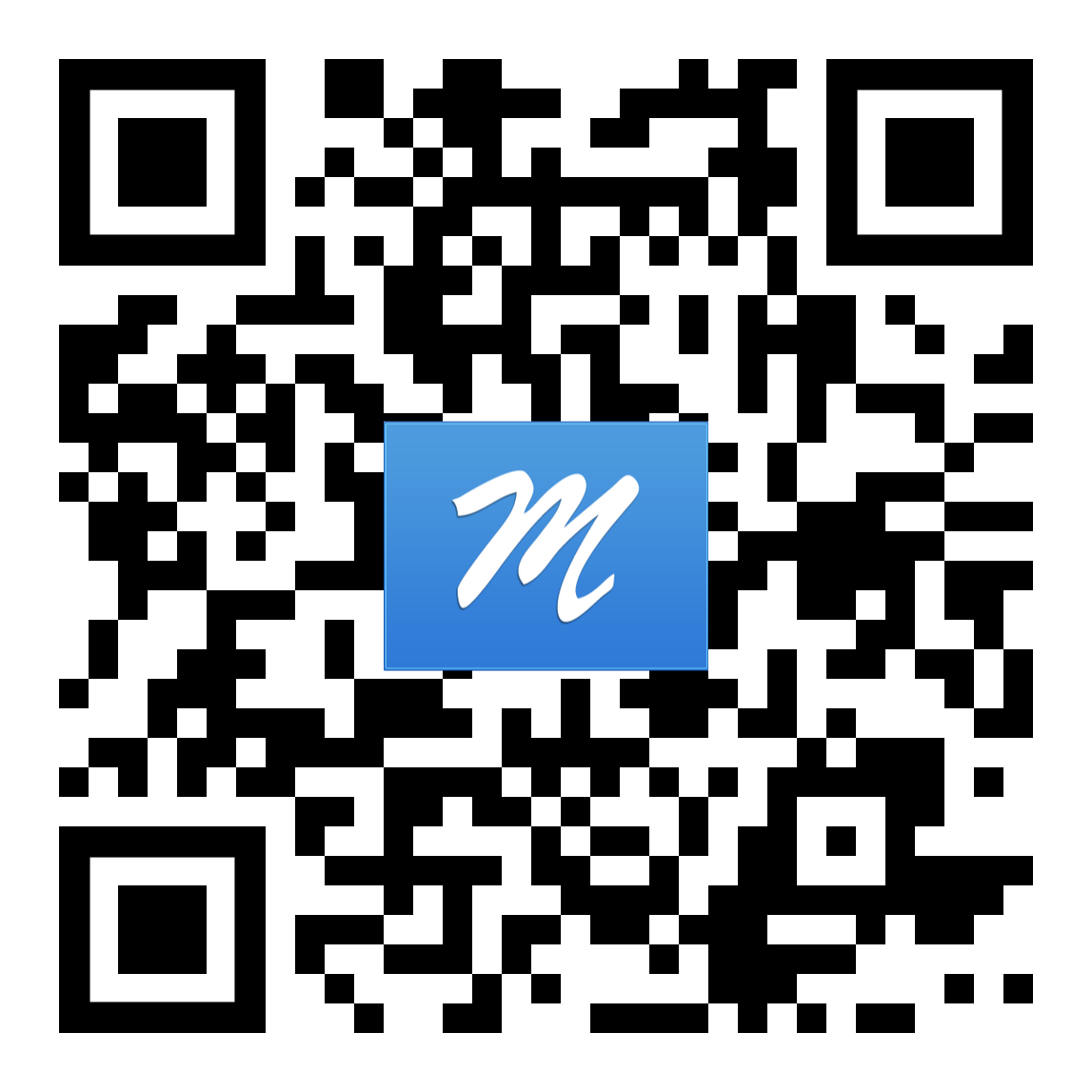Signatures of radioactive isotopes in the $r$-process

LA-UR-21-30370
Matthew Mumpower
INT Radionuclides Workshop
Tuesday October 19$^{th}$ 2021

Center
for Theoretical
ASTROPHYSICS

Los Alamos National Laboratory Caveat
The submitted materials have been authored by an employee or employees of Triad National Security, LLC (Triad) under contract with the U.S. Department of Energy/National Nuclear Security Administration (DOE/NNSA).
Accordingly, the U.S. Government retains an irrevocable, nonexclusive, royaltyfree license to publish, translate, reproduce, use, or dispose of the published form of the work and to authorize others to do the same for U.S. Government purposes.
What is the $r$-process?


Rapid neutron capture that occurs in astrophysical environments allowing for the production of heavy elements
Neutron captures are initially much faster than $\beta$-decays
Relative slowdown in the nuclear flow (right) produces peak structures in the observed abundances (left)
Astrophysical environment must produce a lot of free neutrons in order for this process to proceed
Where can the $r$-process occur?
One possibility is in (rare?) supernovae

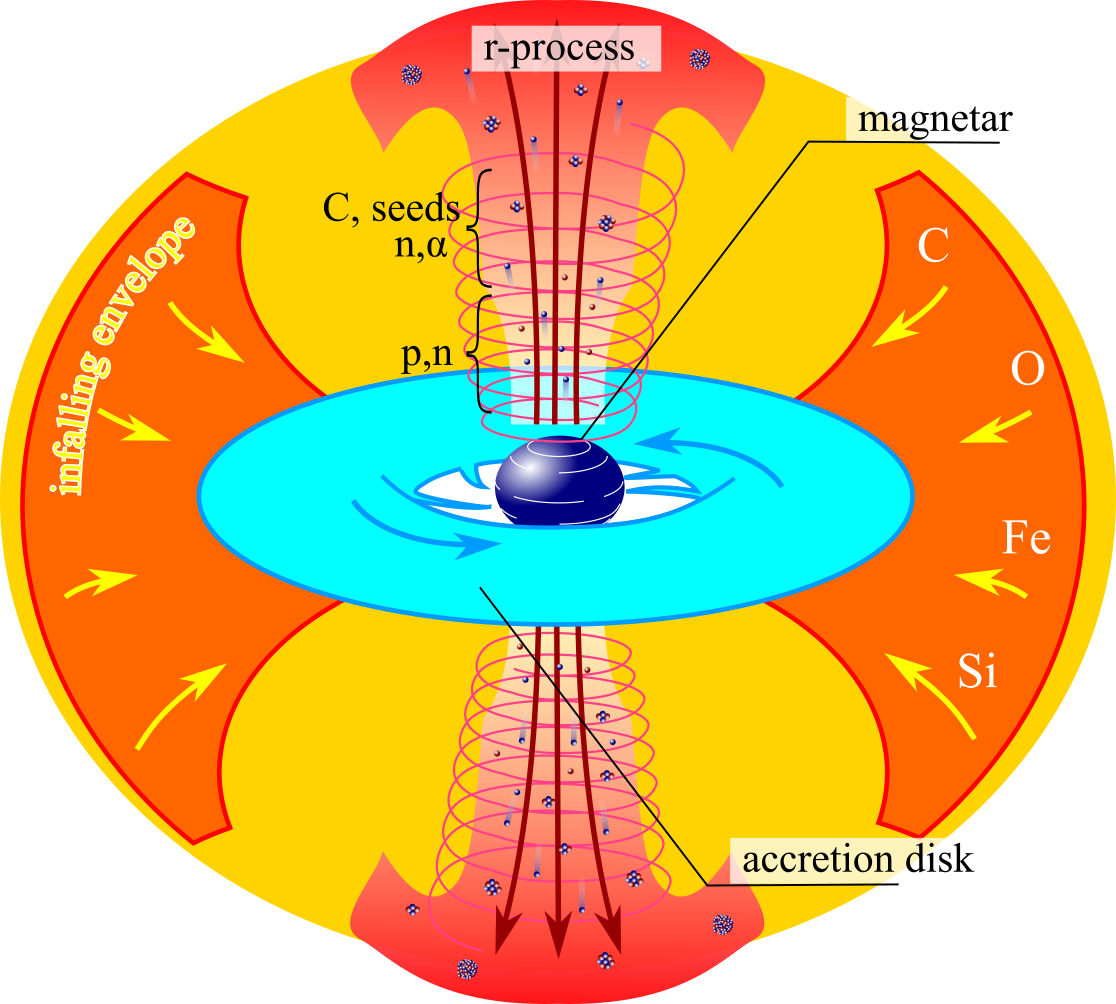
For standard supernovae (left) neutrino physics still needs to be well understood
Jets in magnetorotational driven supernovae (right) may also provide the necessary conditions
Another option is the disk winds of collapsars - black hole forms after core collapse of a rapidly rotating star
Where can the $r$-process occur?
Another possibility is in compact object mergers

A binary merger of neutron stars is an exciting possibility (some indirect evidence exists)
Another option is in the disk of a black hole neutron star binary
How can we observe the $r$-process?
Gravitational waves are emitted by explosive events (can be detected by LIGO)
Electromagnetic signals may be detected from the radioactive decay of heavy nuclei
The problem with EM signals is that we can only detect them if the event is close
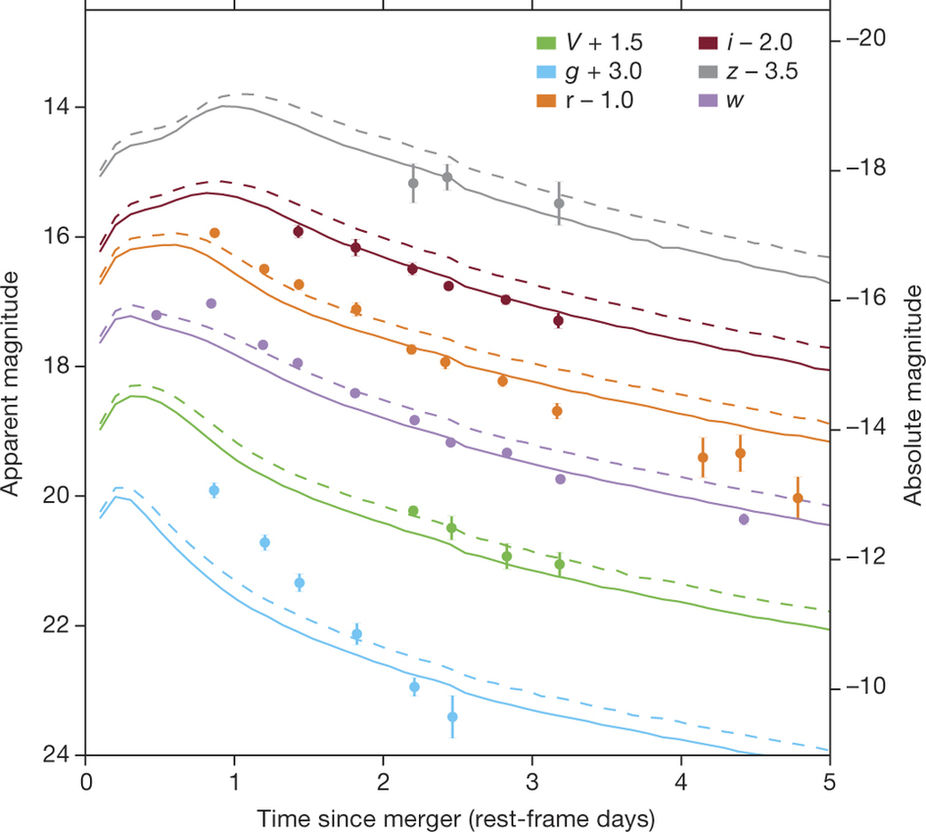
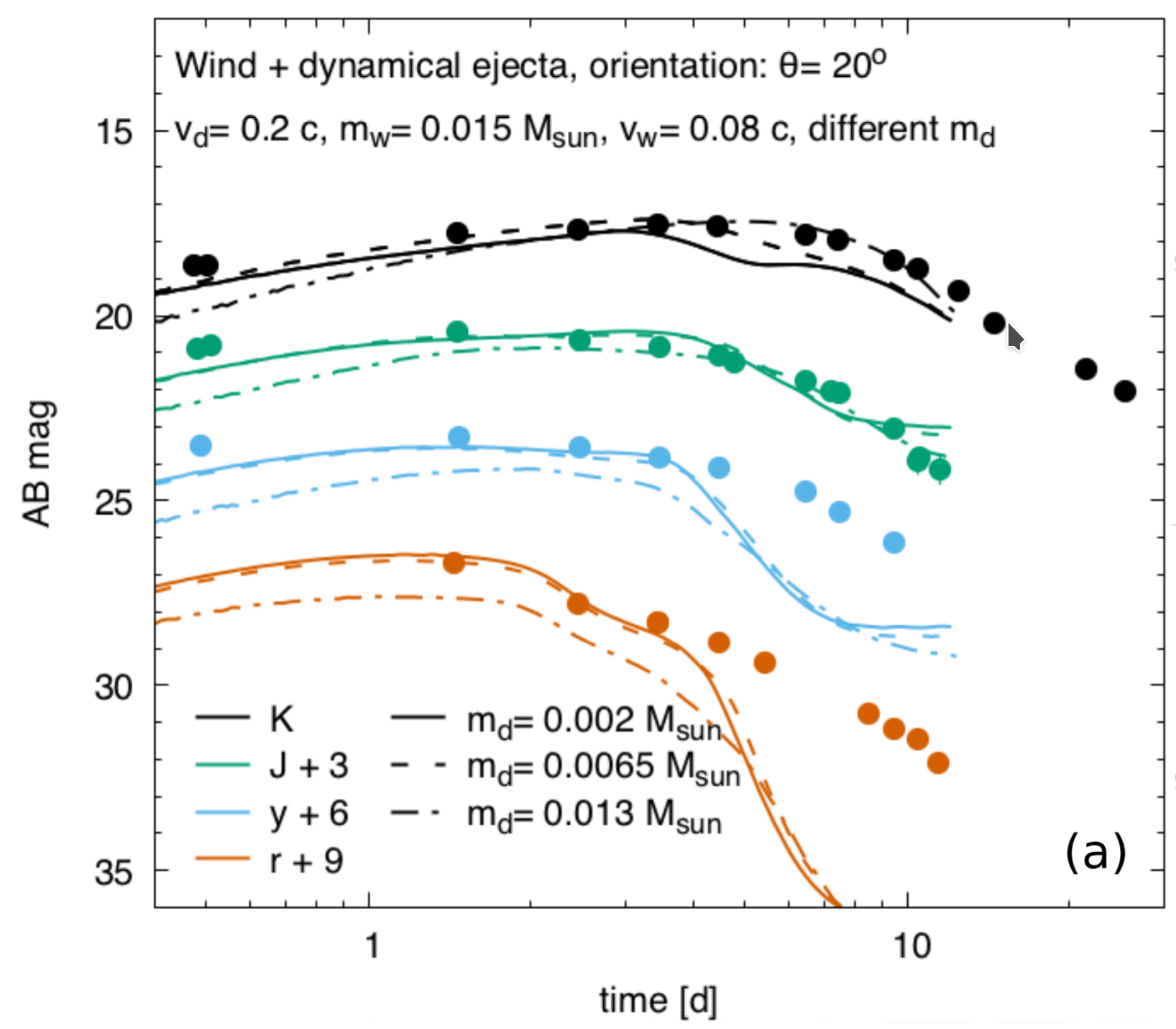
(left) Low lanthanide fraction (right) high lanthanide fraction → major degeneracies in the model space
To understand the formation of the elements
Requires deep knowledge of a range of fields, including:
The theoretical modeling of astrophysical environments
Multi-messenger observations (gravitational waves, EM waves, etc.)
Nuclear theory predictions for exotic nuclei
Precision experiments to constrain nuclear theory
Data and observations are limited
We must be clever when deciphering what is going on with nucleosynthesis...
Especially if we want to find the fingerprints of heavy element formation!
Nuclear physics efforts @ LANL have been focused on
Creating tools for the community to use to understand the $r$-process
Here's a few that will be featured today...
NEXUS
(A computational toolkit for synthesizing nuclear data & modeling relevant nuclear physics properties)
URSA: Unified Reaction Structures for Astrophysics
(A novel way to incorporate the latest nuclear data in astrophysical simulations)
PRISM: Portable Routines for Integrated nucleoSynthesis Modeling
(A state-of-the-art nuclear reaction network)
JADE
(A state-of-the-art decay network for modeling late-time behavior)
Open source releases are available / forth coming!
Radionuclides in the $r$-process

While the nucleosynthesis of the $r$-process is short-lived (~1 second)
The creation of radionuclides spans half-lives from microseconds to near-stable
Different epocs have unique and interesting radioactive nuclei present along with associated signatures
Nucleosynthesis epoch ($\tau \sim 1$ second)

The most uncertain part of the $r$-process
How high up in mass number ($A$) can this process achieve?
We need reliable nuclear theory calculations to address such open questions... (NEXUS / URSA / PRISM)
Novel description of $\beta$-decay: QRPA + HF
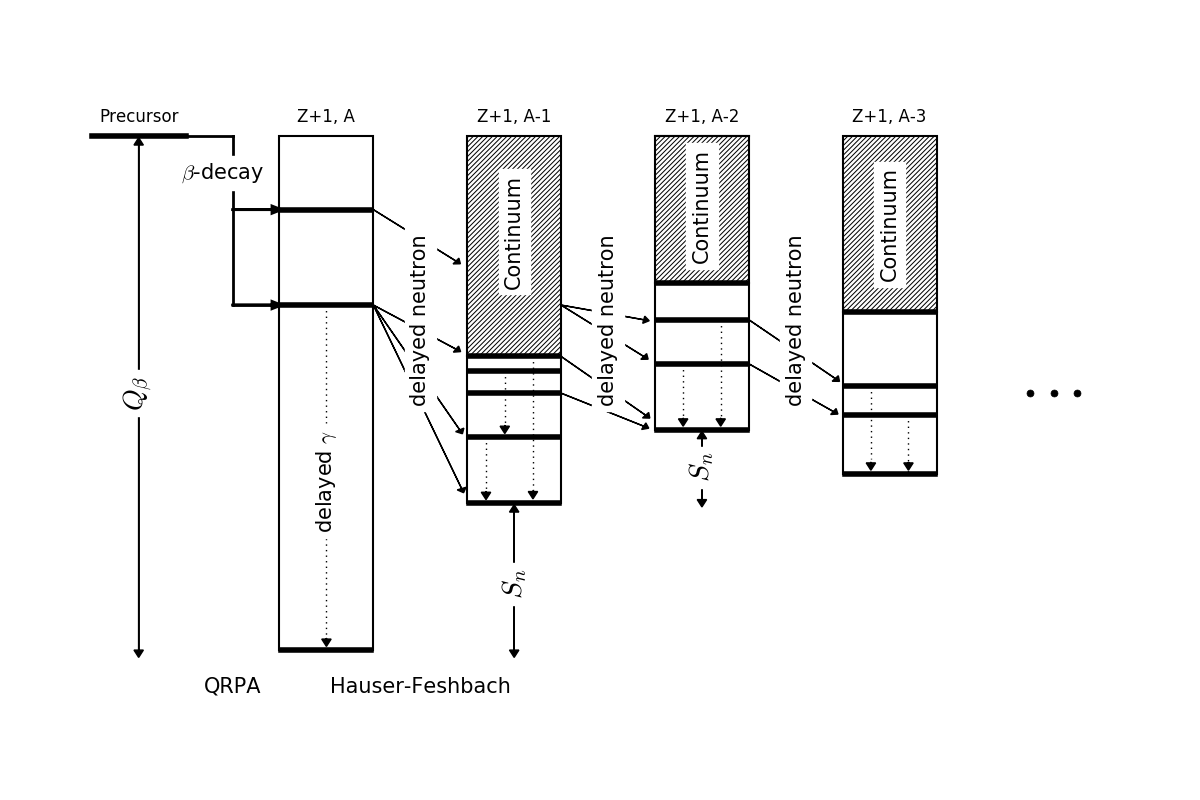
Initial population from the $\beta$-decay strength function from QRPA
Follow the statistical decay via Hauser-Feshbach until all excitation energy is exhausted
Wu et al. PRL 118, 072701 (2017) • Mumpower et al. ApJ 869 1 (2018) • Möller et al. ADNDT 125 (2019)
Average neutron emission
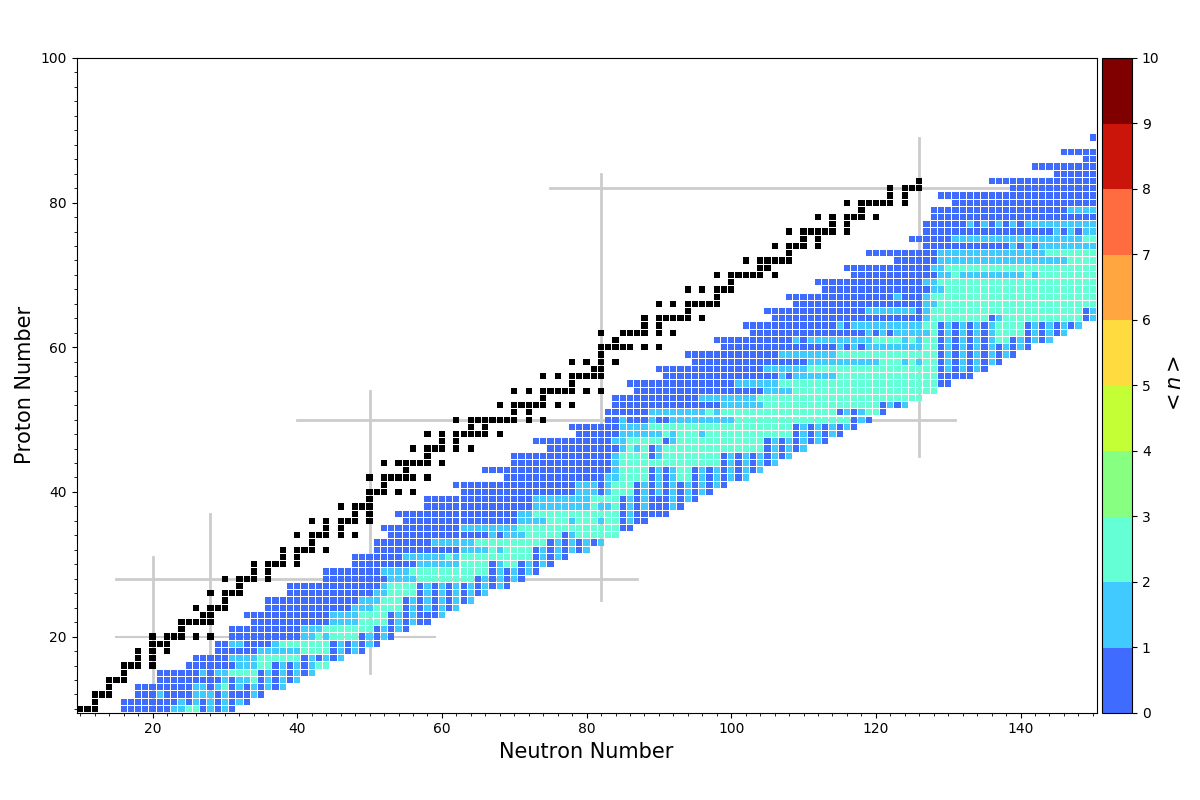
Apply energy window method to the entire chart of nuclides
Problem with describing very neutron-rich nuclei
Average neutron emission
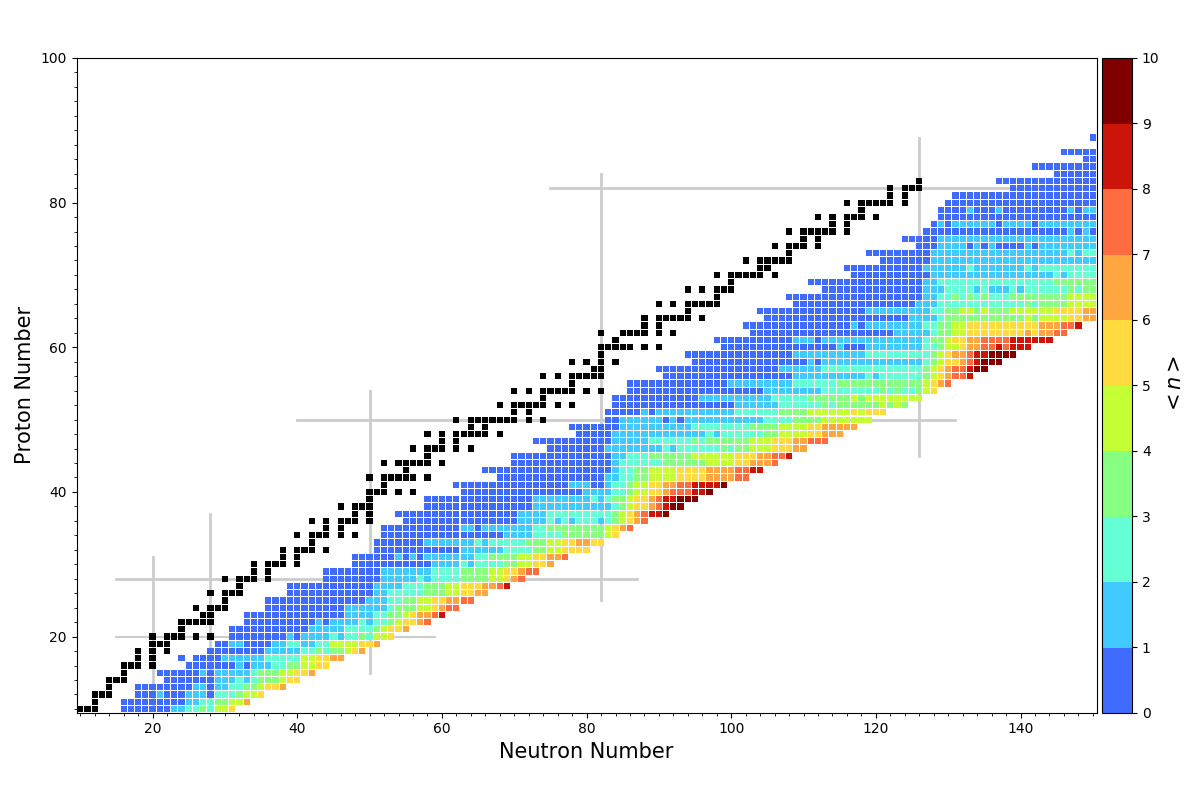
Apply the QRPA+HF method to the entire chart of nuclides
Problem with neutron-rich nuclei goes away
$\beta$ -delayed fission
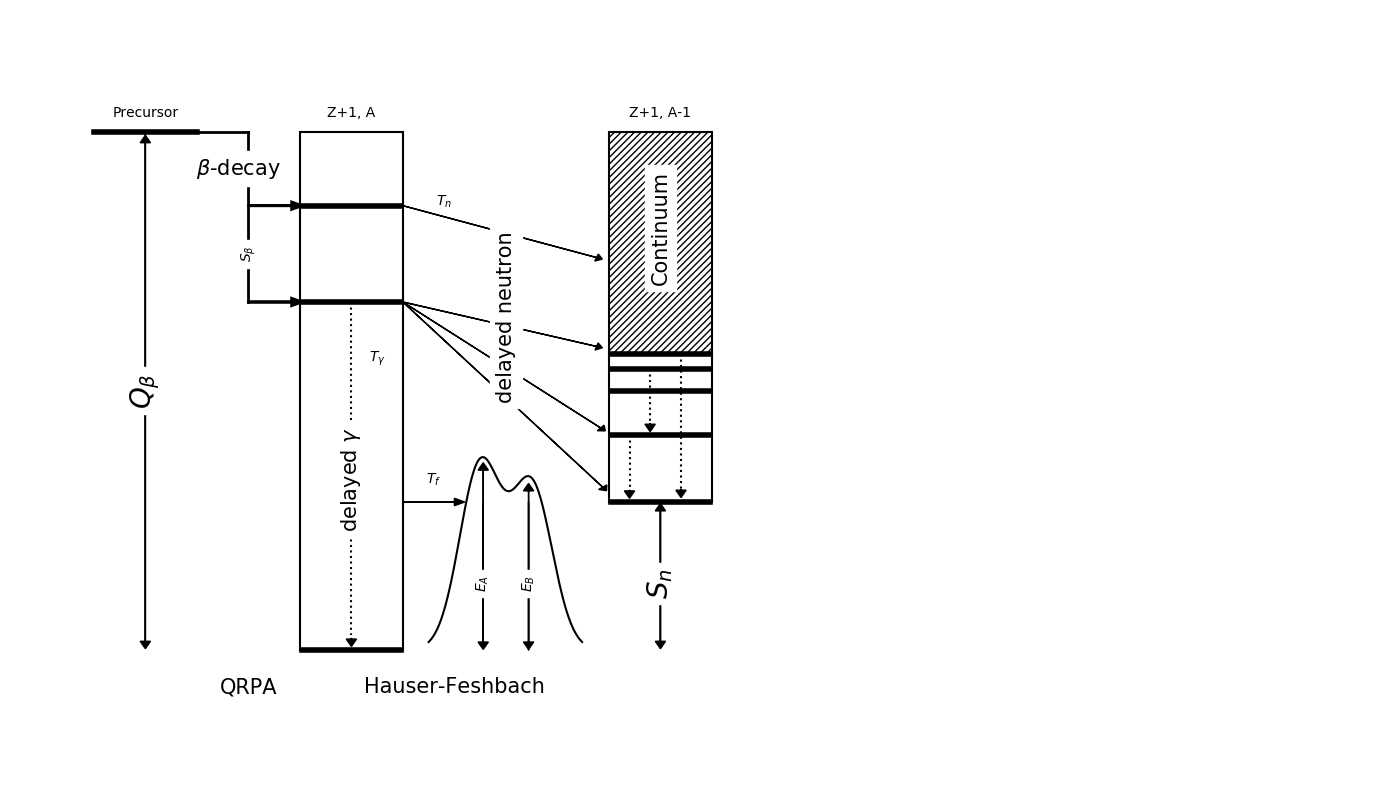
We have recently extended our QRPA+HF model to describe $\beta$-delayed fission ($\beta$df)
Barrier heights from Möller et al. PRC 91 024310 (2015)
Assumes a Hill-Wheeler form for fission transmission
Yokoyama et al. PRC (2019) • Mumpower et al. ApJ (2018)
Multi-chance $\beta$ df
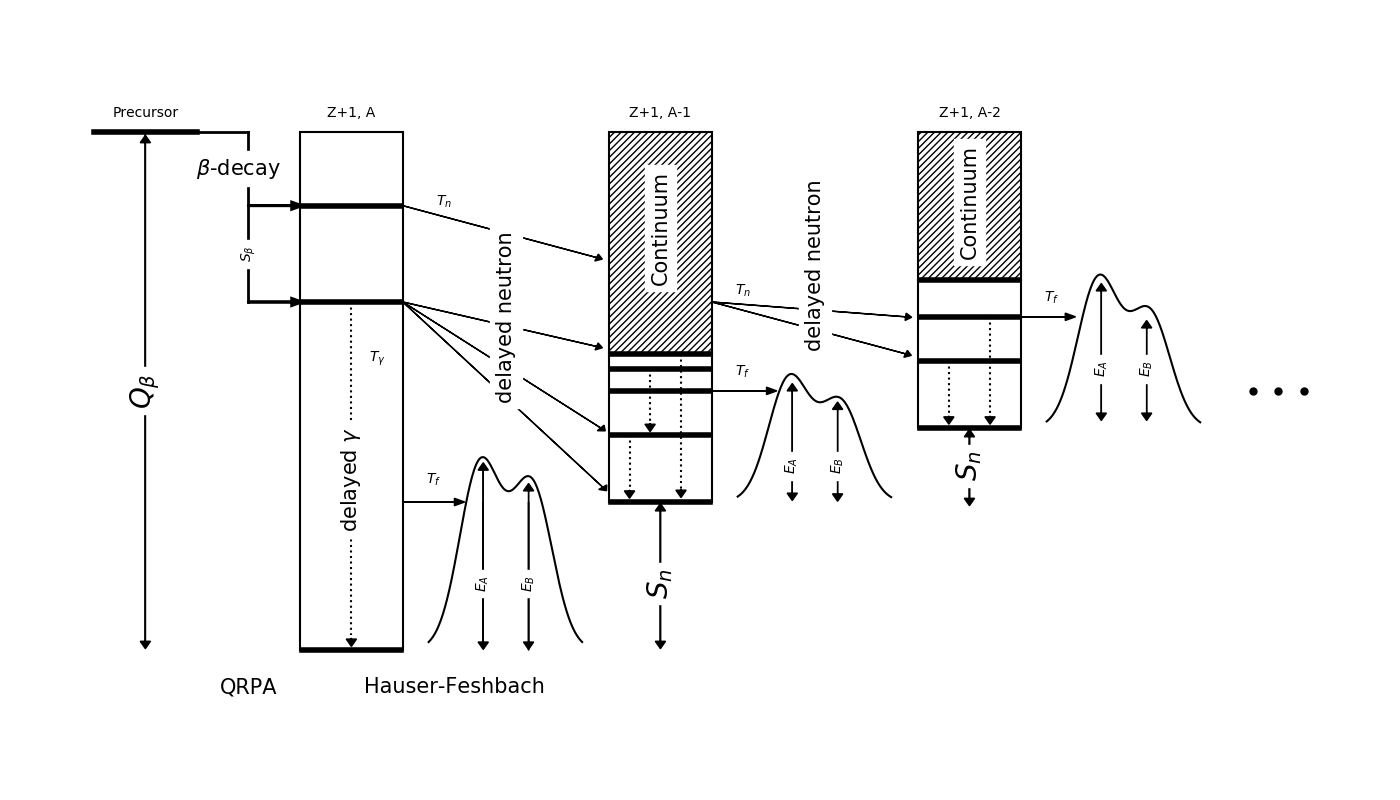
Recall: Near the dripline $Q_{beta}$ ⇡ $S_{n}$ ⇣
Multi-chance $\beta$df: each daughter may fission
The yields in this decay mode are a convolution of many fission yields!
Yokoyama et al. PRC (2019) • Mumpower et al. ApJ (2018)
Cumulative $\beta$ df probability
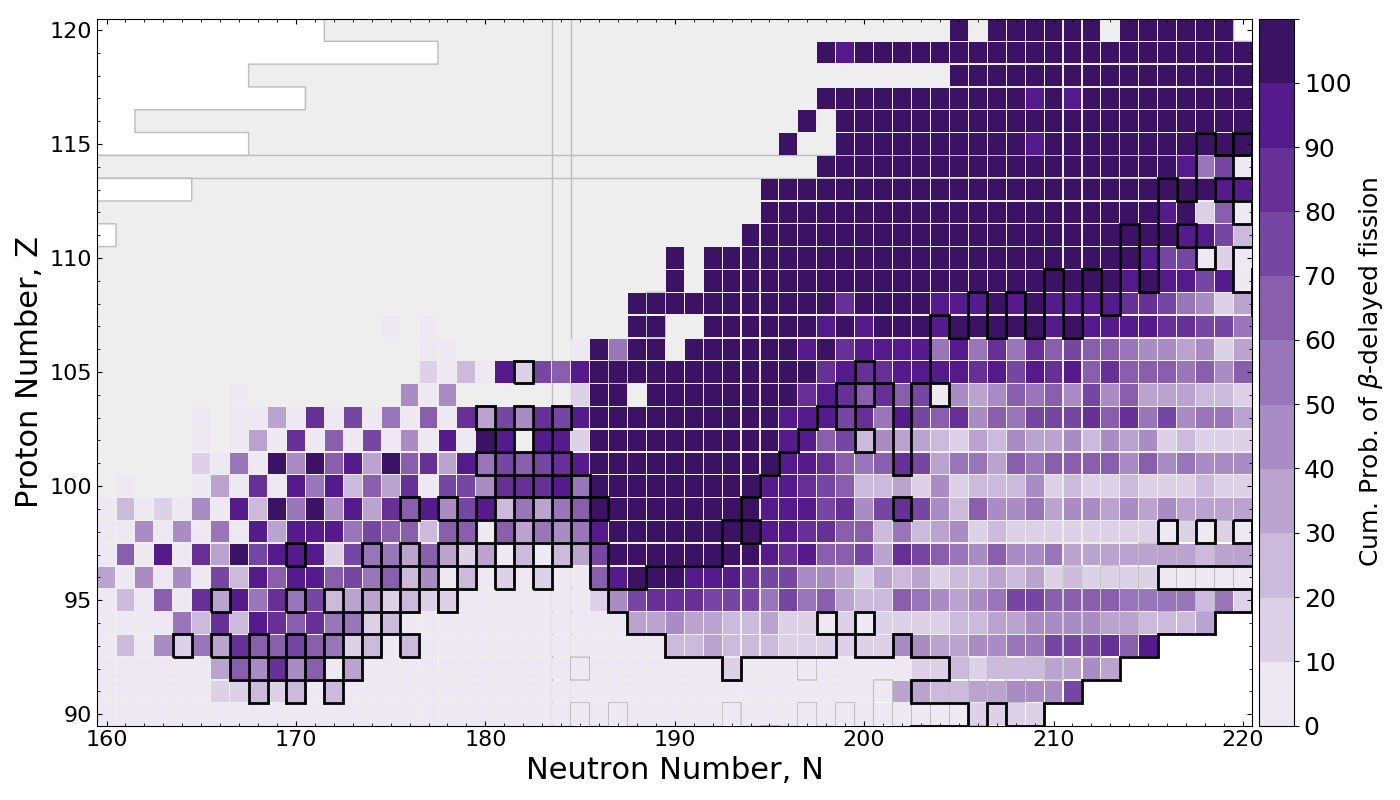
$\beta$df occupies a large amount of real estate in the NZ-plane
Multi-chance $\beta$df outlined in black
Superheavies in the $r$-process
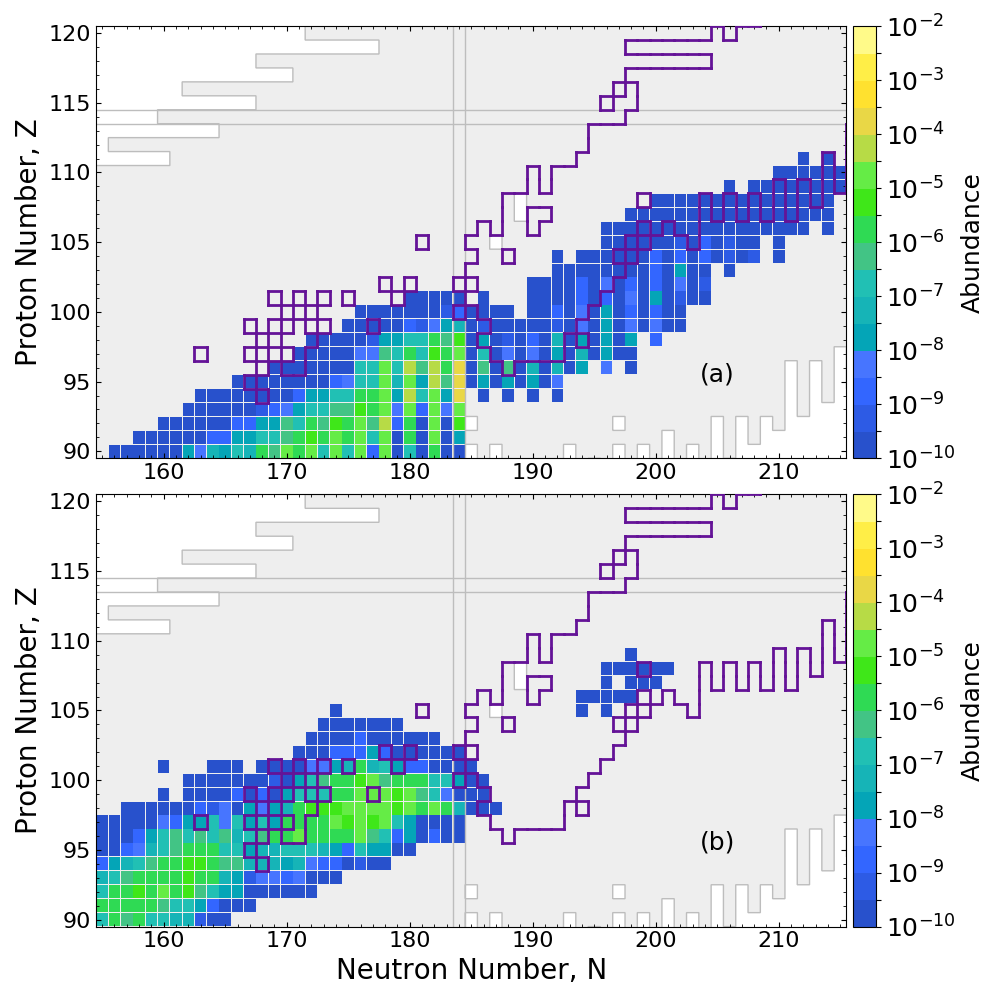
Network calculation of tidal neutron star merger ejecta
$\beta$df alone may prevent the pathway from neutron-rich nuclei to the island of stability
Fission can impact final abundances
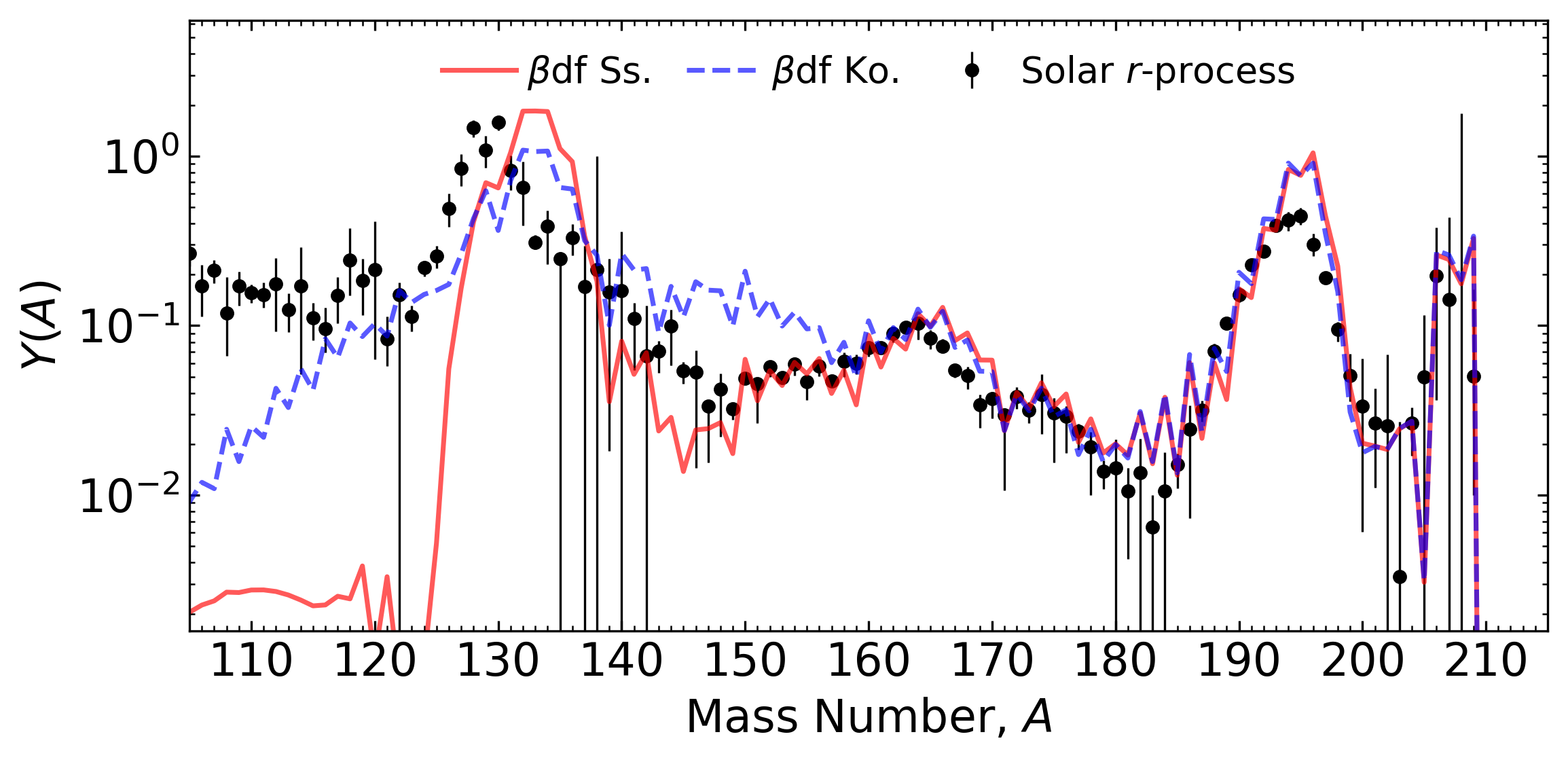
Network calculation of tidal ejecta from a neutron star merger (FRDM2012)
$\beta$df can shape the final pattern near the $A=130$ peak
This is because of a relatively long fission timescale
Conclusion ⇒ we need a good description of fission yields to understand abundances near $A\sim130$.
Nuclear fission

We're also interested in describing the mass and charge yields that arise from nuclear fission
Fission is a complex process in which a heavy nucleus splits into lighter fragments
Fission rates and branching determine re-cycling (robustness)
Fragment yields place material at lower mass number; barriers determine hot spots
Large Q-value ⇒ impacts thermalization and therefore possibly observations
Responsible for what is left in the heavy mass region when nucleosynthesis is complete ⇒ "smoking gun"
FRLDM fission yields
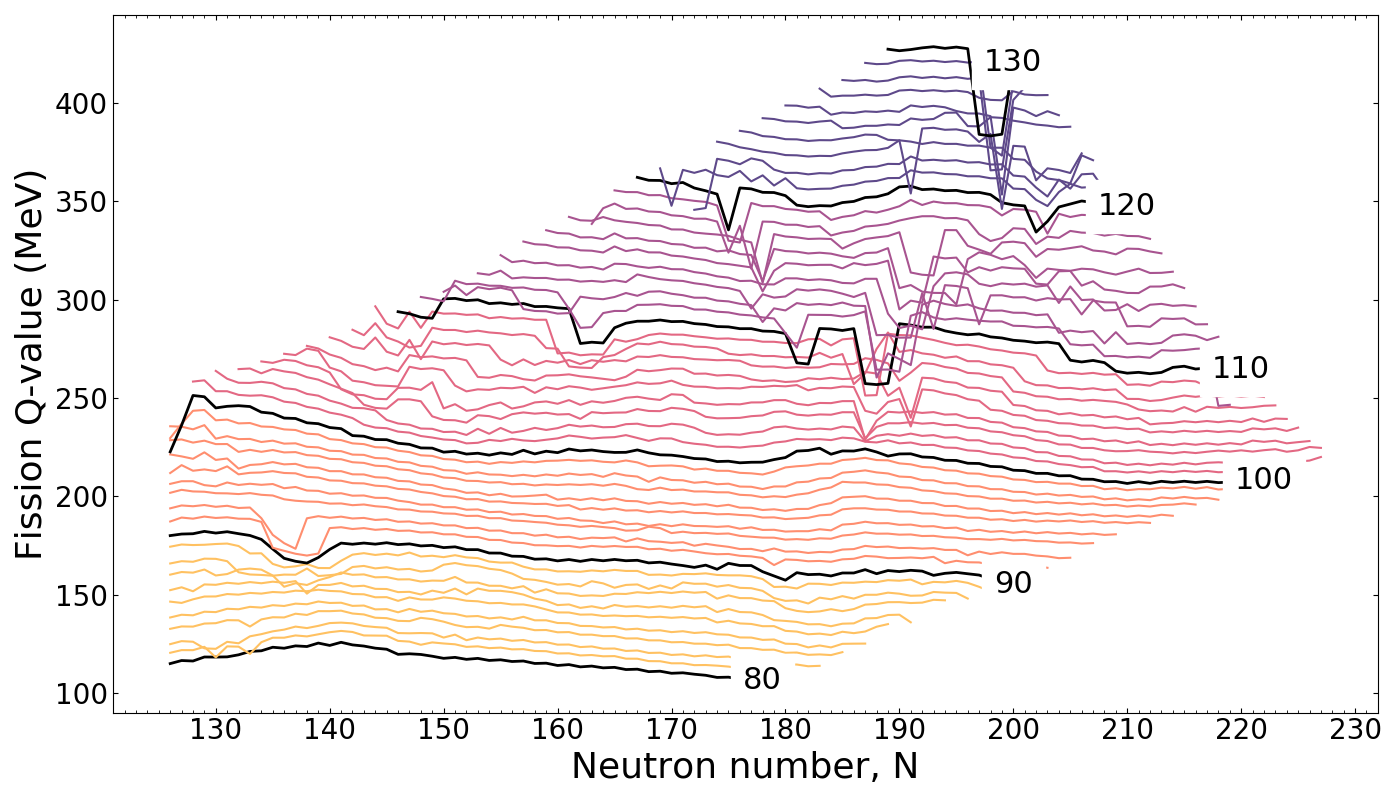
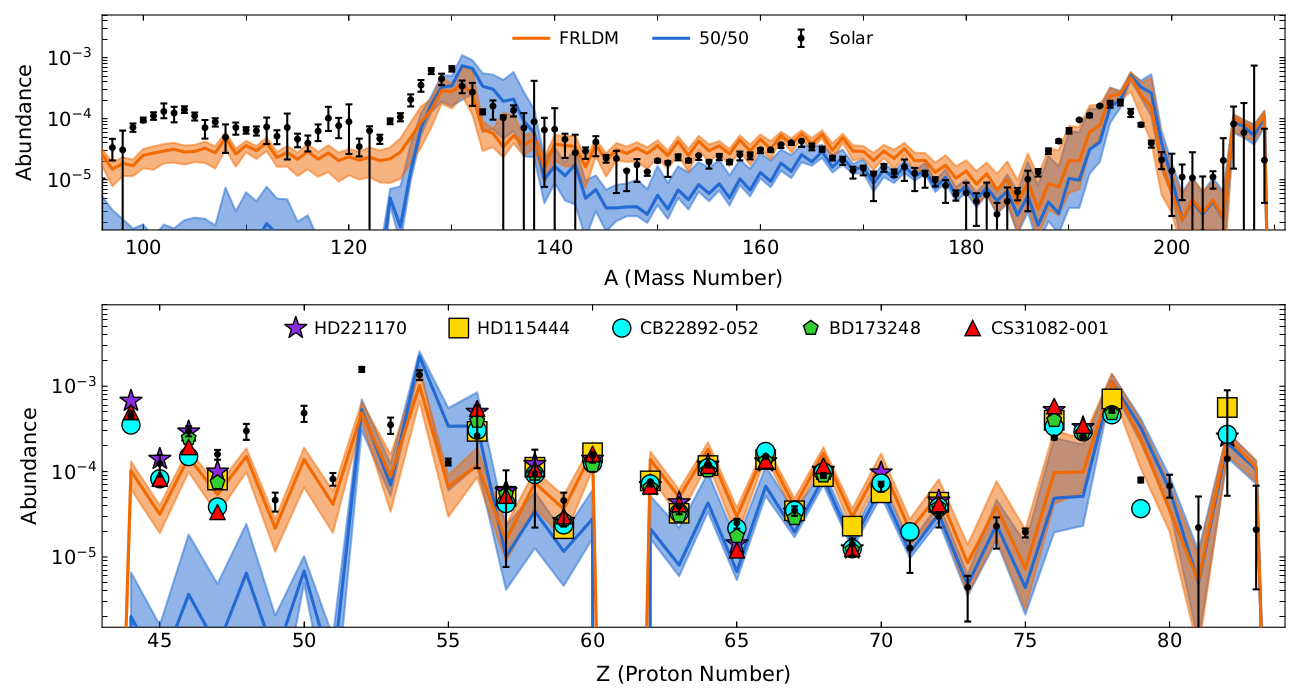
Left panel: A complete description of fission yields suggests energy release depends mostly on fissioning system charge number
This is important for predictions of early time heating in the $r$-process
Right panel: Fission might be responsible for the extension of universality down to the precious metals
More complete observations with metal poor stars would be very helpful!
See Nicole's presentation on Thursday for more lanthanide & actinide signatures!
eFRLDM Results: $^{235}$U + n$_{\rm{therm}}$
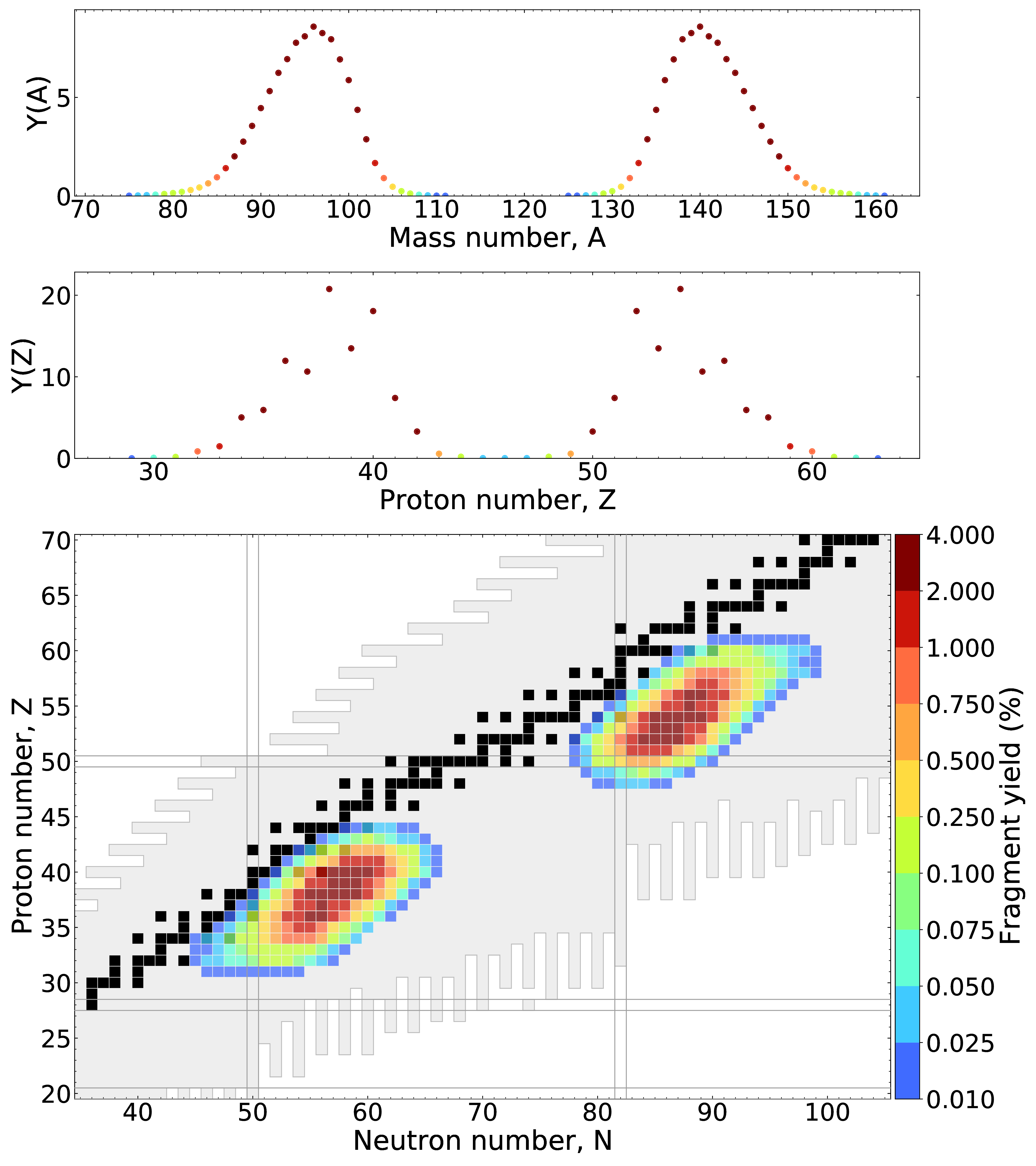
We recently improved our fission modeling and can now describe Y(A), Y(Z) and Y(Z,A) simultaneously
eFRLDM Results: $^{235}$U + n$_{\rm{therm}}$
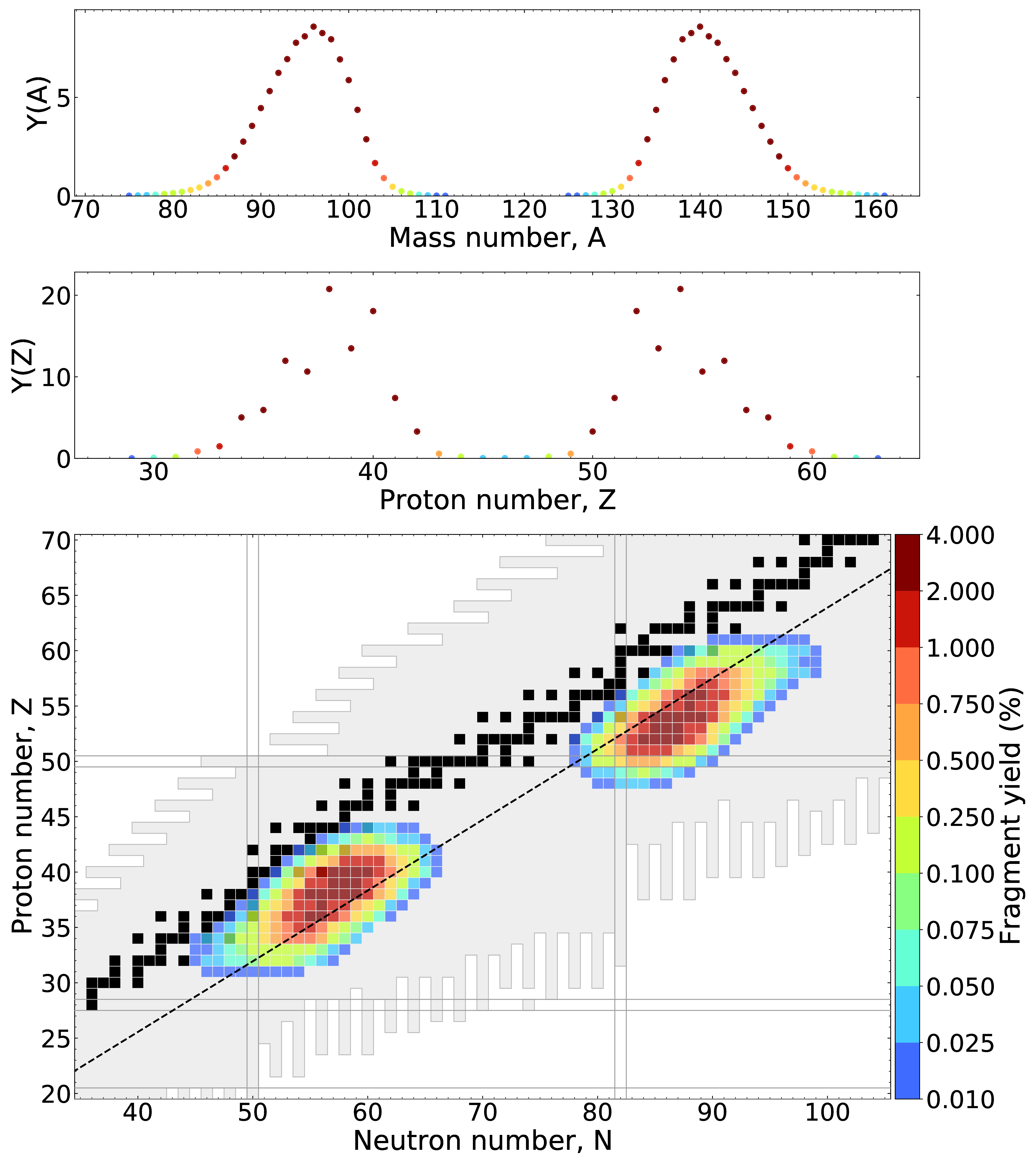
Fragment yields no longer follow unchanged charge distribution (UCD) assumption (Blacked dashed line)
eFRLDM Results: $^{235}$U + n$_{\rm{therm}}$
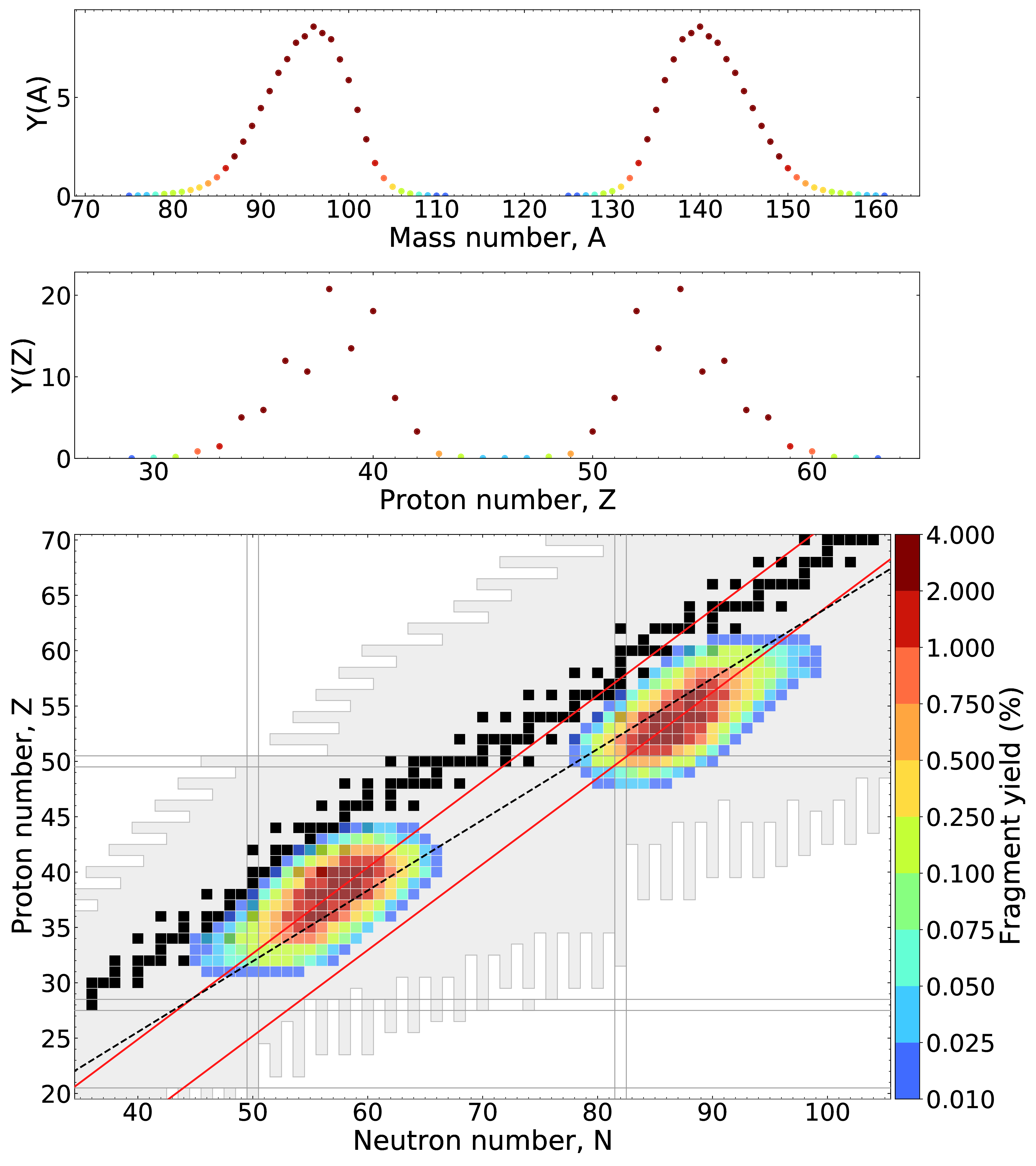
Charge polarization offset predicted and in agreement with experimental measurements (red lines)
An example case: $^{258}$Fm ($Z=100$)
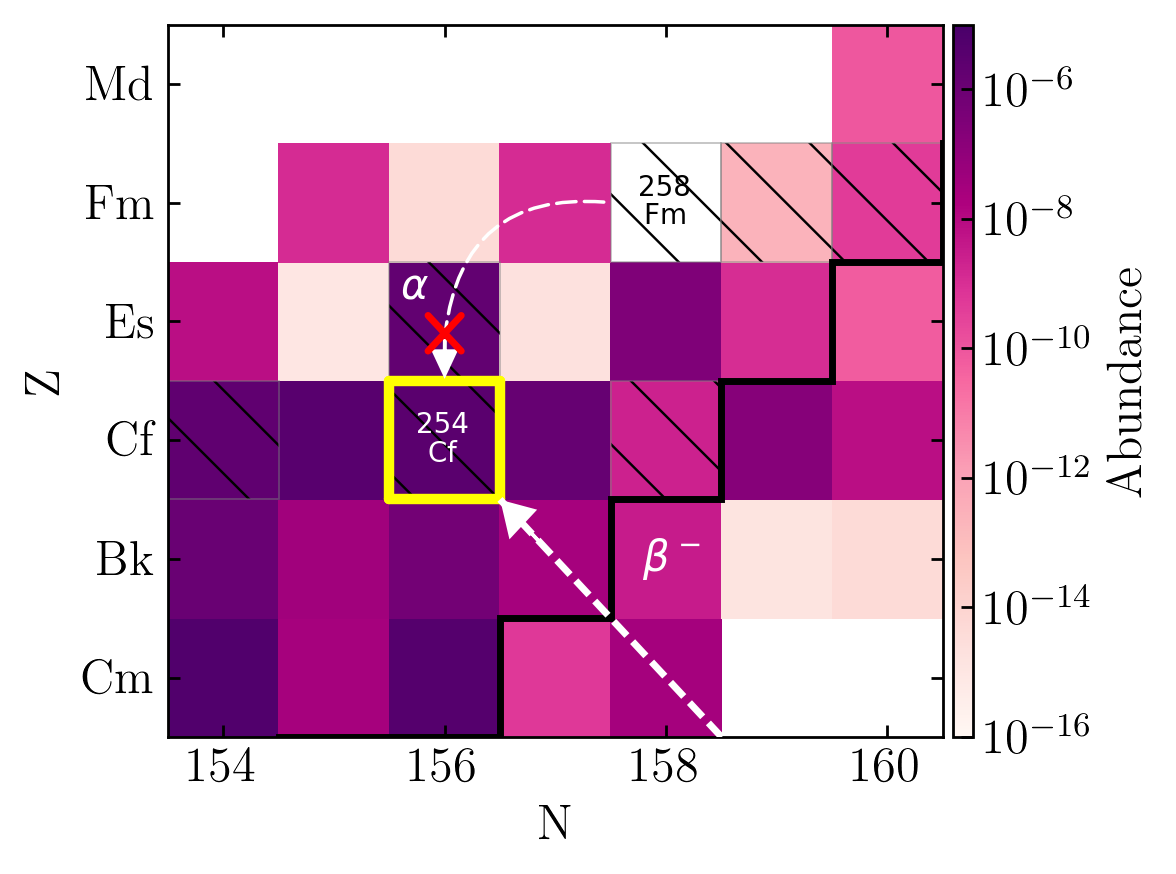
$^{258}$Fm is a nucleus with a half-life of several hundred microseconds (populated in the nucleosynthesis epoch)
$^{258}$Fm has a small, but potentially non-trivial $\alpha$-decay branching to $^{254}$Cf; it primarily spontaneously fissions
To fully understand the potential implications of $^{254}$Cf production we need to have better measurements of $^{258}$Fm
We'll return to the importance of $^{254}$Cf soon (trasient epoch)...
Freeze-out epoch ($\tau \sim$ seconds to days)

Nuclear transmutations are better constrainted; but we still lack information on excited states & particle spectra
Longer lived isomers are potentially populated and interesting ('astromers')
Some nuclei are strong contributors to the radioactive heating
A decay network is ideal for describing the physics of this timescale... (PRISM / JADE)
Isochronic Evolution
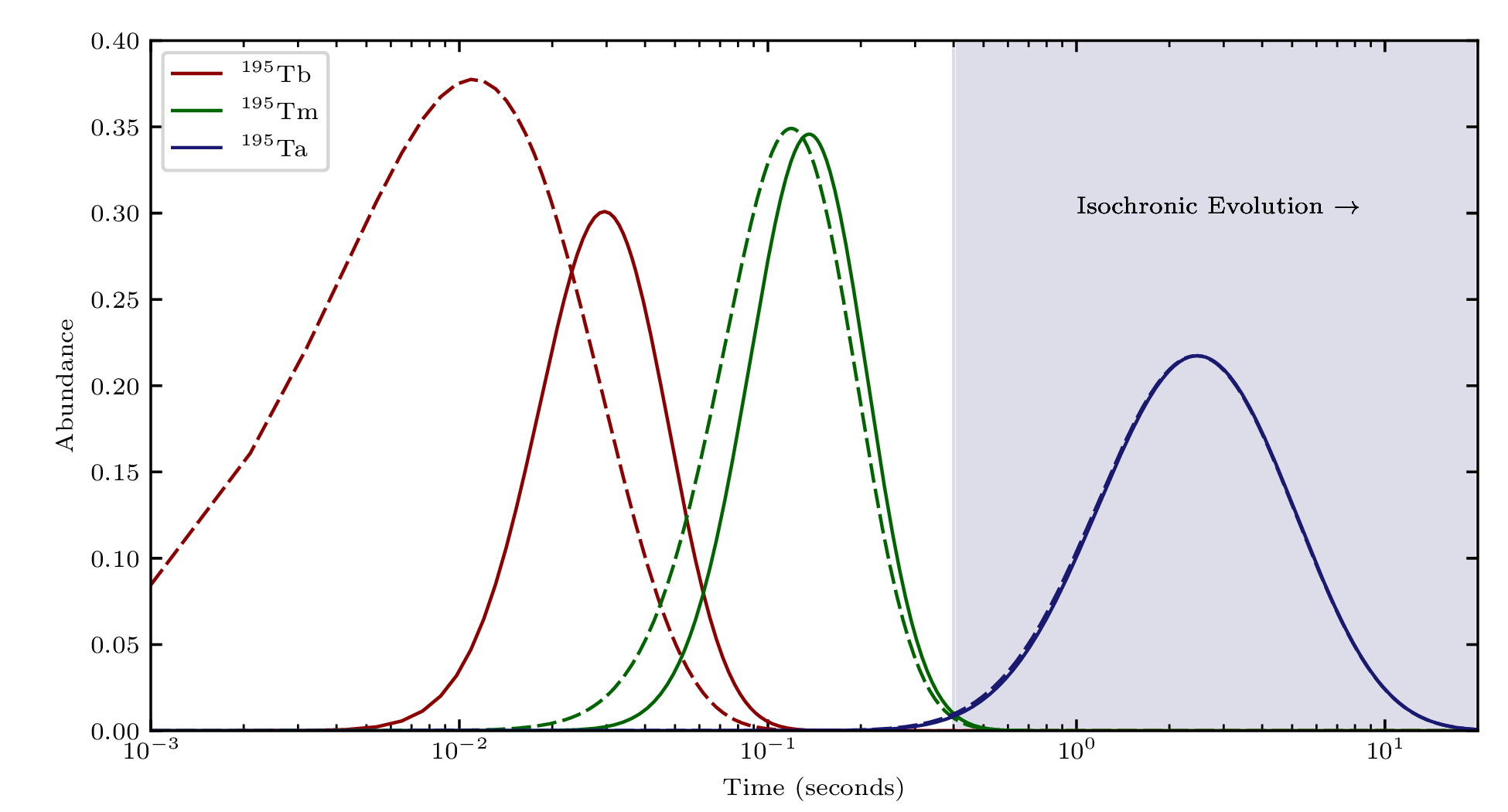
If you wait long enough the evolution of abundances is isochronic
This means: two different distributions (solid vs dashed) early on later converge to the same curve; memory of initial state is lost
The bulk of r-process ejecta will undergo such an evolution; fission complicates this picture...
Astrophysically metastable nuclear isomers (astromers)
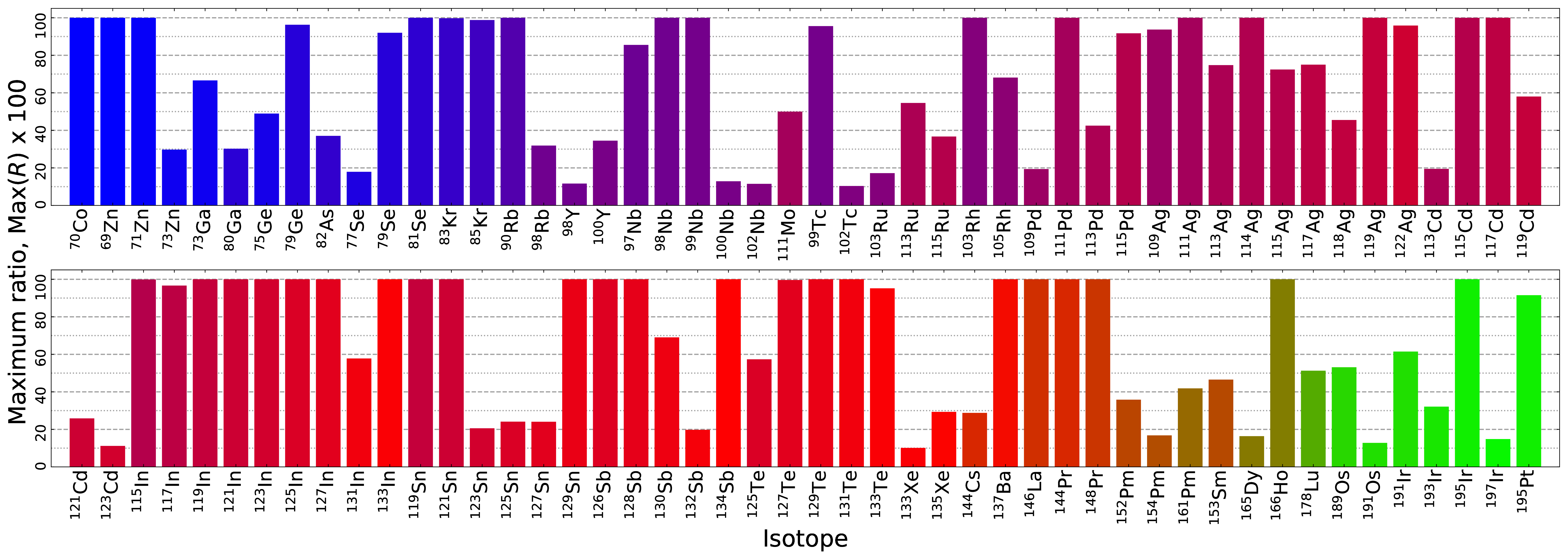
Isomers are dynamically populated in the $r$-process
Their contributions to heating, light curves and observations can be quantified
Work pioneered by LANL postdocs: G. W. Misch (see Friday's presentation) & T. M. Sprouse
Nuclear databases are incomplete - there are certainly even more populated in the $r$-process!
Astrophysically metastable nuclear isomers (astromers)
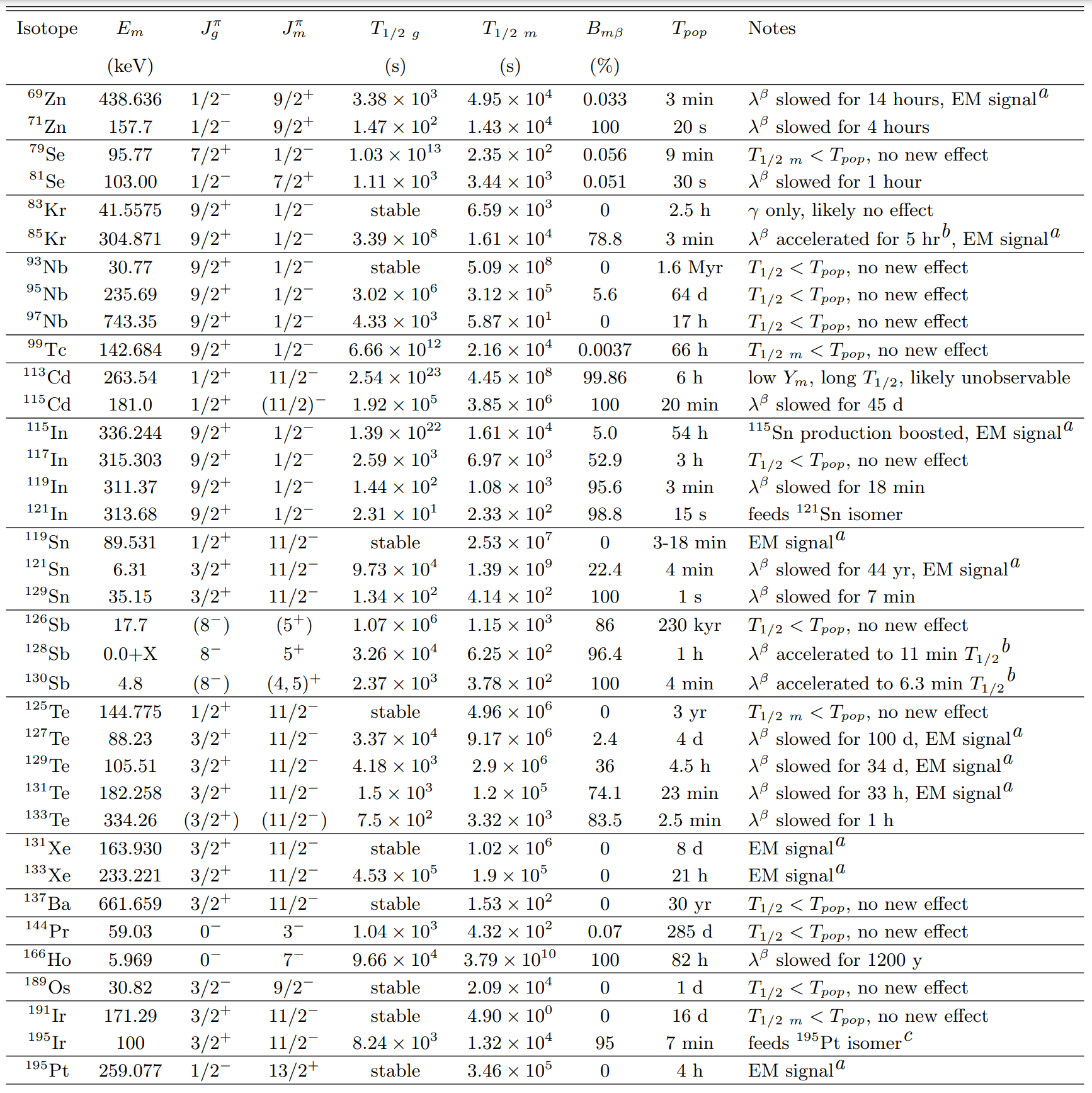
A wide variety of nuclei are found with unique signatures
Radioactive heating
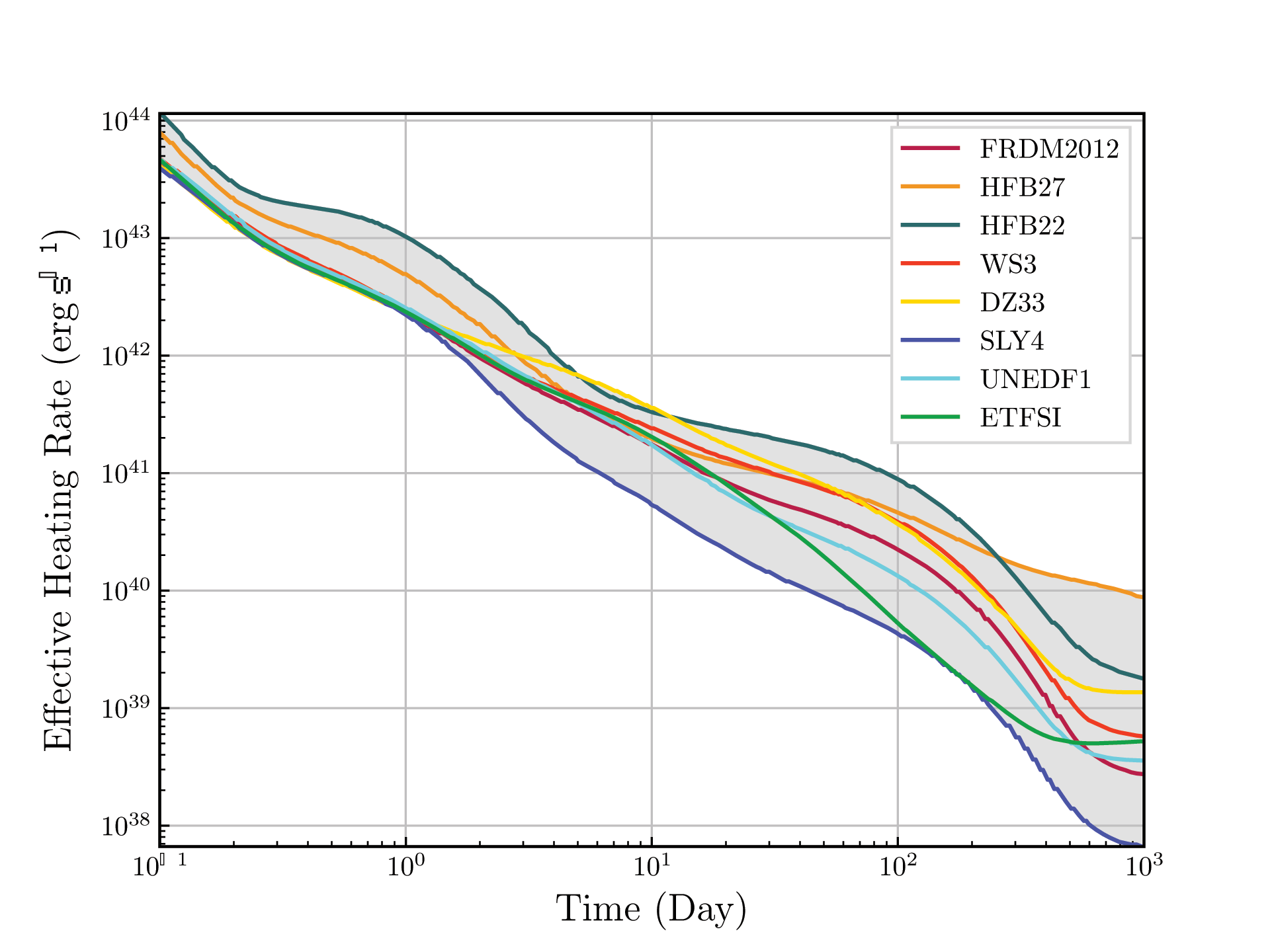
Variation in radioactive heating from uncertainties in nuclear binding
Interesting nuclei can control energy release on characteristic timescales... e.g. I, La, Rf isotopes (see Kelsey's presentation)
Transient epoch ($\tau \sim$ days to weeks?)

Observationally interesting time period for a nascient $r$-process event
We must blend astrophysical simulations, nuclear physics and atomic physics to describe observables
Nebular phase requires non-LTE physics (hard!)
$\gamma$-rays from mergers

If the $r$-process source is very close we might disentangle different compositions (colored lines)
Signatures of major emitters can come through (many second peak elements: e.g. isotopes of I, Sb, Sn)
Fission $\gamma$-rays from mergers
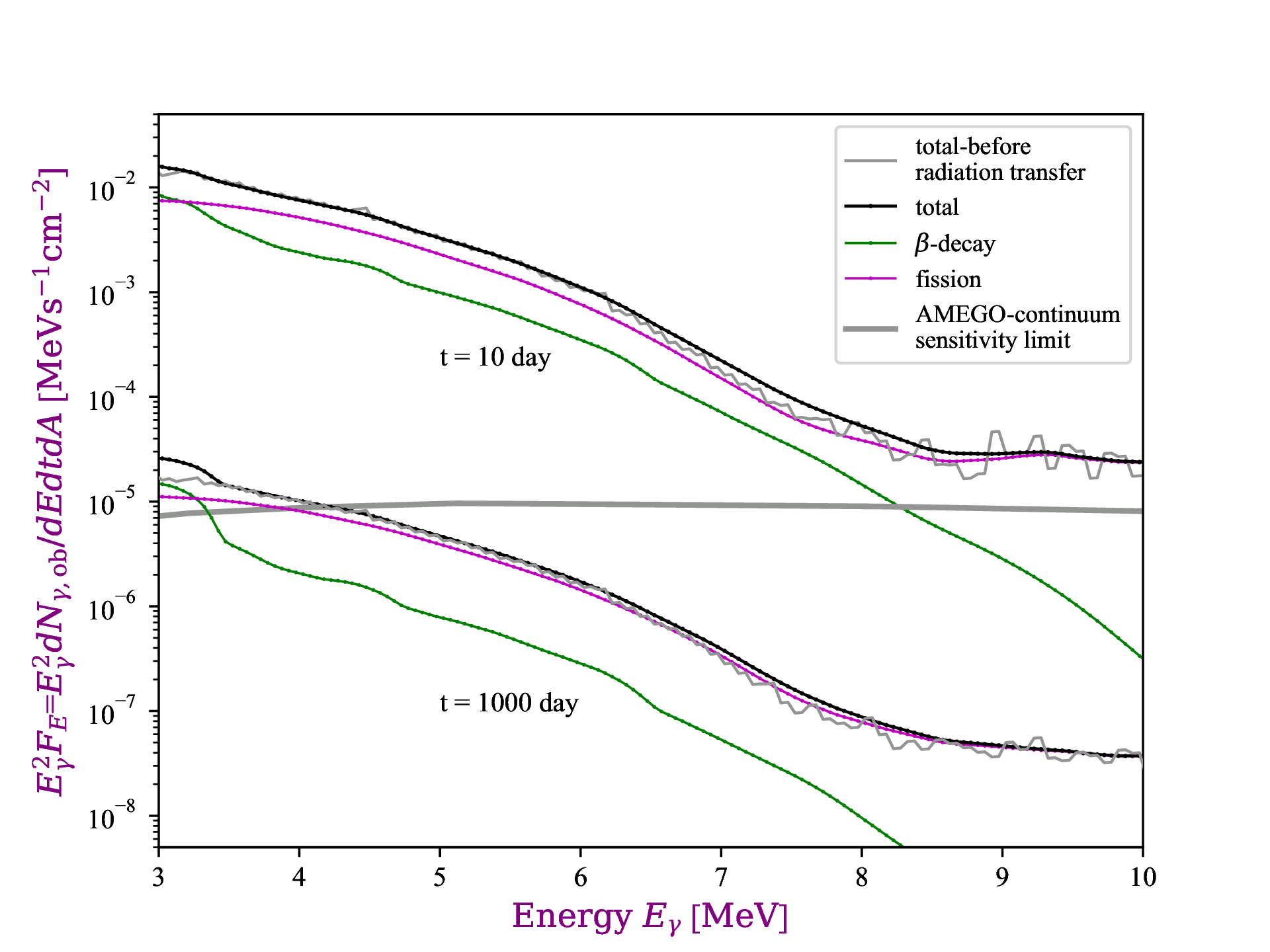
$\gamma$-rays from fission have a distinct (higher energy) spectra
Spectra is smooth; cannot detect presence of individual radionuclides
It is however indicative of fission occuring (no other process can create such high energy $\gamma$'s)
Returning to $^{254}$Cf
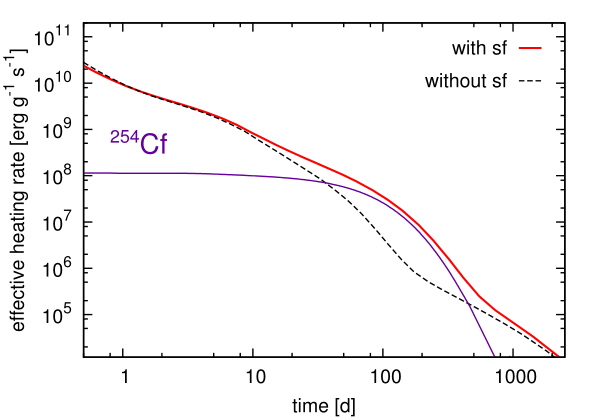
Can we prove that all of heavy elements nucleosynthesis has occurred in an event?... Maybe!
The spontaneous fission of $^{254}$Cf can be a primary contributor to nuclear heating at late-time epochs
The $T_{1/2}\sim 60$ days; found from nuclear weapons testing
Vassh et al. J. Phys. G (2019)
Production of $^{254}$Cf(Z=98)
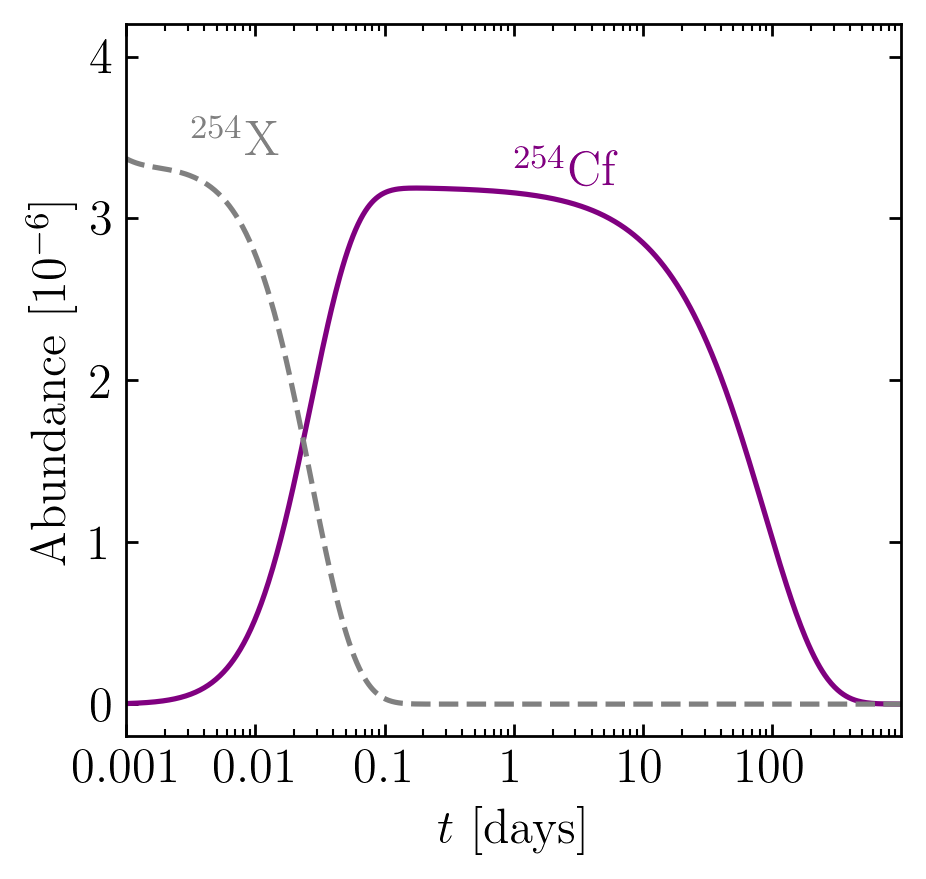

Primary feeder seems to be from $\beta$-decay
Production of this nucleus been explored over a range of nuclear models; some high - some low
Remains to be seen if we can disentangle from other energy sources (e.g. puslar or accreetion fallback)
Observational Impact of Californium
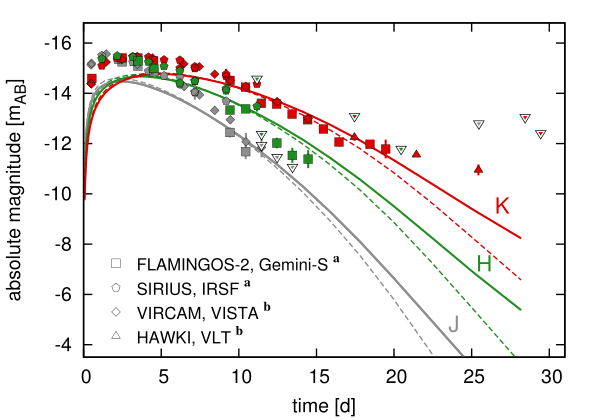
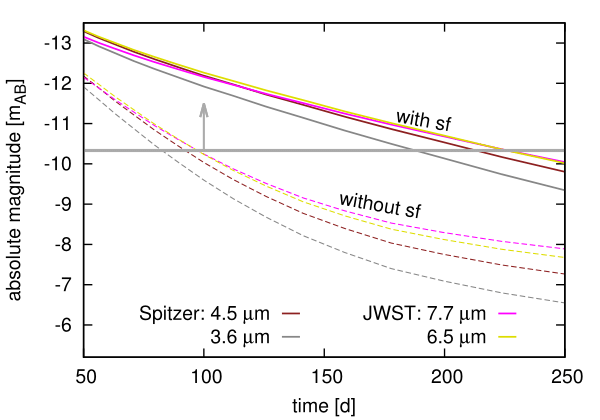
Both near- and middle- IR are impacted by the presence of $^{254}$Cf
Late-time epoch brightness can be used as a proxy for heavy element nucleosynthesis
Future JWST mission could detect $r$-process event out to 250 days with the presence of $^{254}$Cf
This also has implications for compact object merger morphology...
Other nuclei remain interesting (e.g. $^{260}$Md with $T_{1/2} \sim 30$ days)
Remnant epoch ($\tau \sim$ weeks? and longer)

Observationally interesting time period for a long-past $r$-process event
Longer-lived radionuclides of interest during this epoch
Particle spectra for radionuclides
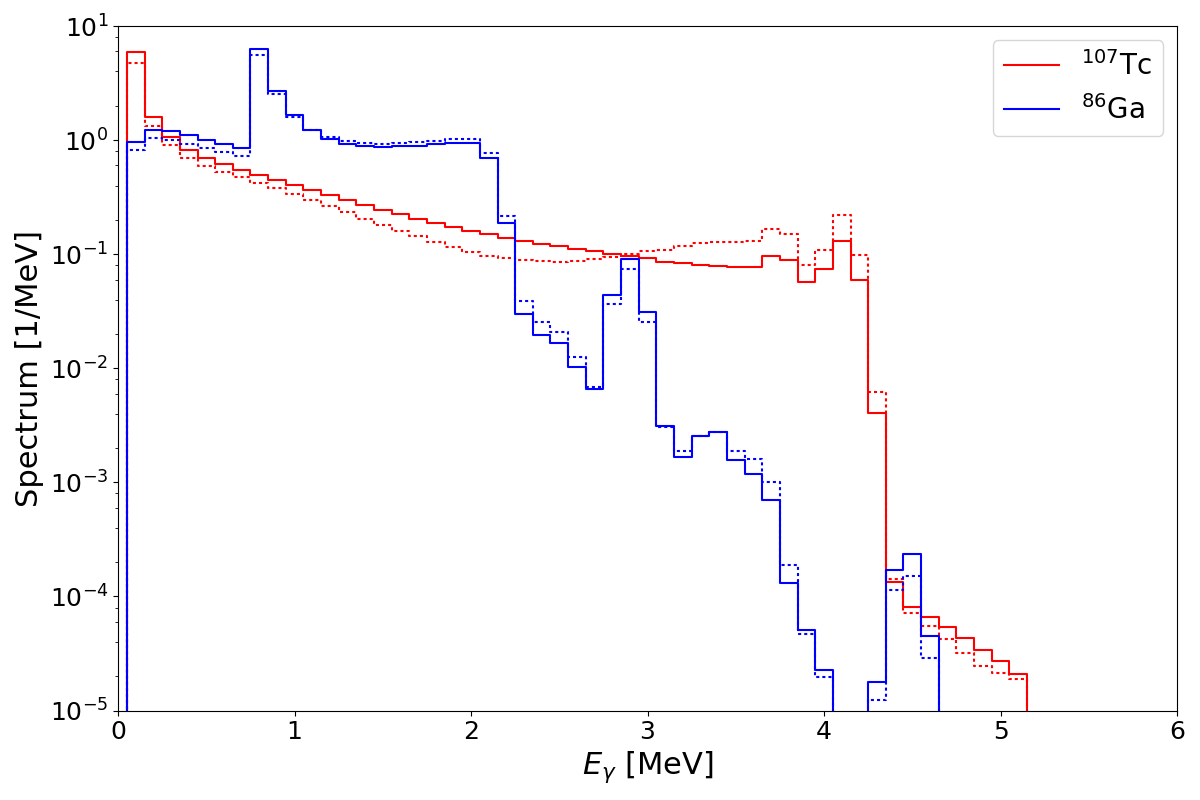
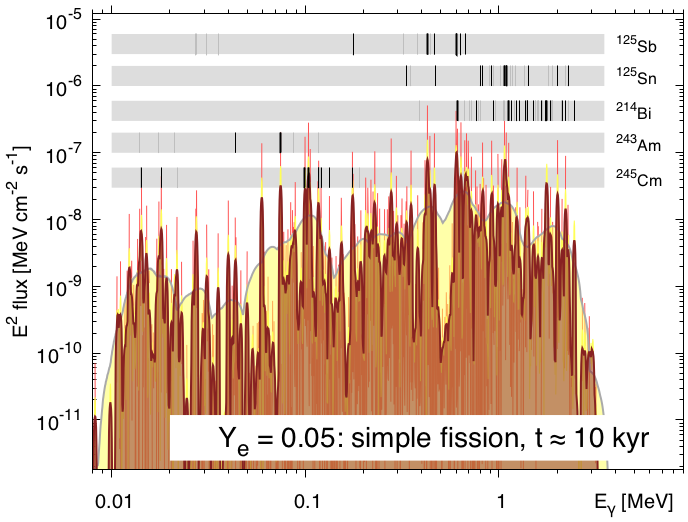
Our QRPA+HF model is also capable of producing predictions of particle spectra coupled with evaluations (left)
Benchmarking these quantities provides a more sensitive test of the model beyond integral quantities such as $P_n$
Both theory & data are influential in predicting observational signatures e.g. $\gamma$-rays from remnants (right)
Measurements focused on decays can provide a new handle on potential 'smoking gun' $r$-process nuclei
$^{213,214}$Bi($Z=83$) are strong $\gamma$-emitters that have short half-lives but can be generated by longer-lived species
On even longer timescales...
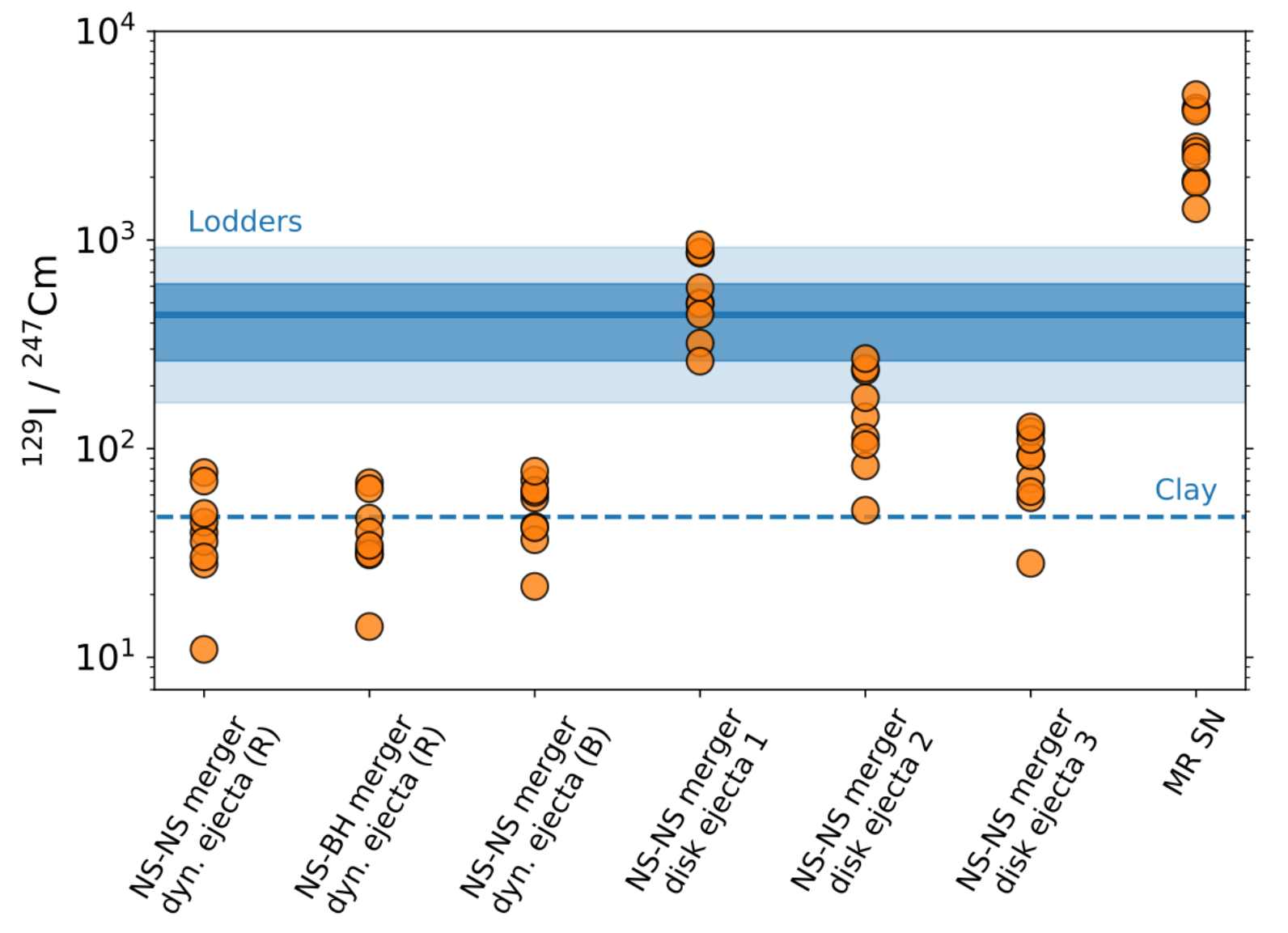
The $^{129}$I to $^{247}$Cm ratio offers a unique insights into the $r$-process
These radionuclides have nearly identical half-lives (15 Myrs), but are widely separated in mass
See Benoit's talk on Friday!
Special thanks to
My collaborators!
Summary
We need accurate nuclear data and reliable nuclear physics models to understand $r$-process nucleosynthesis
Recent advances:
We have developed a state-of-the-art research pipeline for studying nuclear physics in nuclear astrophysics
We have developed theoretical tools to interpret experiments and gauge impact in astrophysical environments
We have recently compiled new mass, reaction, decay and fission predictions across the chart of nuclides
Providing novel insights into radionuclides of the $r$-process and their associated signatures in various epochs
Results / Data / Papers @ MatthewMumpower.com
